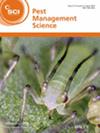Effect of tree height and spraying methods on Diaphorina citri kuwayama endosymbionts in the context of Huanglongbing disease management in citrus orchards
Abstract
BACKGROUND
Huanglongbing (HLB) (caused by Candidatus Liberibacter asiaticus) is the most damaging disease of citrus around the world. This study investigated the effects of citrus tree height on Diaphorina citri Kuwayama mortality, endosymbiont responses, and HLB distribution.
RESULTS
The results reveal that the age of citrus trees plays a significant role in psyllid mortality. Interestingly, the cumulative mean mortality (%) of psyllids over the seven-day observation period was higher (31.50±0.03) when four-year-old (501A1, 502A2, 501A3) citrus trees were sprayed with a US-SMART mechanical sprayer. In contrast, the psyllids mortality was 0.09±0.23 for the 13-year-old citrus trees (104A2, 104A3, 104C1) sprayed with a US-SMART mechanical sprayer and 9.10±0.05 for 13-year-old (502A2, 502B2, 502D1) citrus trees sprayed with a fixed US-SMART mechanical sprayer. Our findings also revealed that psyllids from both four- and 13-year-old citrus trees carried Candidatus Carsonella ruddii species and Wolbachia, the primary and secondary endosymbionts, respectively. Surprisingly, infection rates of these endosymbionts remained consistent across different age groups, as confirmed by quantitative polymerase chain reaction analysis. Furthermore, our study highlights the significance of tree height as a proxy for tree age in influencing HLB occurrence. Specifically, four-year-old citrus trees subjected to the US-SMART mechanical sprayer for citrus psyllid control demonstrated effective disease management compared to 13-year-old (104A2, 104A3, 104C1) citrus trees sprayed with US-SMART mechanical sprayers. Additionally, the investigation explored the impact of tree height on HLB distribution. In four-year-old trees, no significant correlation between HLB disease and tree height was observed, potentially due to effective spray coverage with US-SMART mechanical sprayer. However, in 13-year-old (104A2, 104A3, 104C1) citrus tree sprayed with US-SMART mechanical sprayer, a positive correlation between tree height and HLB disease was evident.
CONCLUSION
This research provides valuable insights into the complex interaction between citrus tree age, psyllid endosymbionts responses, and HLB distribution. These results emphasize effective HLB management strategies, especially in orchards with diverse tree age populations, ultimately contributing to the long-term sustainability of citrus cultivation. © 2023 Society of Chemical Industry.

 求助内容:
求助内容: 应助结果提醒方式:
应助结果提醒方式:


